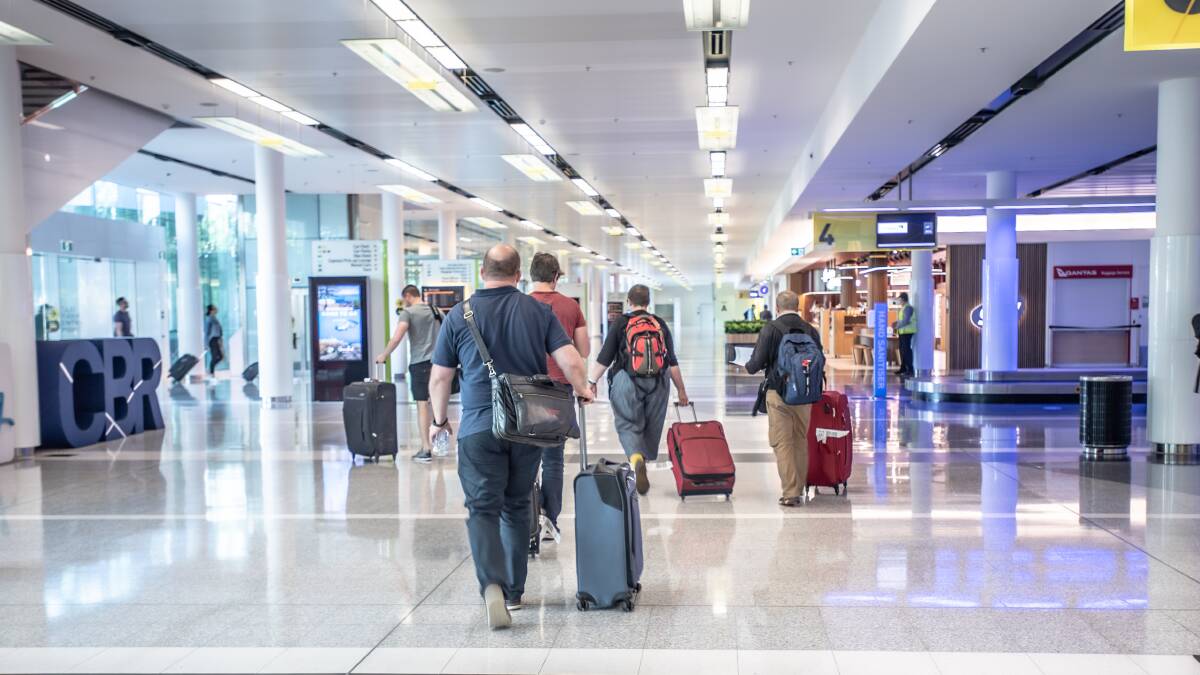
We are thinking we will get back to 60 per cent of pre-COVID domestic levels by Christmas depending on borders opening in Queensland.
- Qantas CEO Alan Joyce
One of the world's busiest air routes kicked off again on Monday.
Subscribe now for unlimited access.
or signup to continue reading
Flights between Sydney and Melbourne were able to resume on Monday, as NSW opened its border to Victoria at midnight.
There were jubilant scenes at Sydney Airport as Melburnians stepped onto the tarmac.
As well, there were similar scenes at Canberra Airport as the ACT also reopened its border to Victoria on Monday.
The resumption of flights between Australia's two largest capital cities is a milestone for domestic travel in a post-COVID world. But what will domestic travel look like and how much is it expected to cost in coming months?
How much is a Sydney to Melbourne flight?
The Qantas website, which includes Jetstar flights, shows that for the month of December the cheapest one-way flight is $123, but most return trips are more than $400, as of Monday afternoon.
What about other popular routes?
Most of Australia's other popular routes are currently restricted due to border closures.
Many of the country's busiest routes are between Sydney or Melbourne and places in Queensland. The Sunshine State has indicated borders will be open by Christmas.
If Sydneysiders were to book a flight between Brisbane and Sydney, Australia's second most popular route, on Christmas Eve the lowest one-way cost from Sydney to Brisbane is $153 on Qantas and Jetstar, and $195 on Virgin Airlines.
However, NSW residents outside of Sydney are able to travel to Brisbane and can stopover at Sydney Airport. The cheapest one-way flight between the cities this Saturday is $165 with Virgin and $187 with Jetstar.
Other popular routes, without restrictions, include flight paths in Queensland: Brisbane to Cairns and Brisbane to Townsville, which are priced one-way from $155 and $285, respectively, on Virgin this Saturday.
There is the Canberra to Melbourne route, which is priced one-way from $245 on Qantas this Saturday, but most flights are more than $400. As well, Brisbane to Perth is priced from $410 on Jetstar.
How important will domestic travel be to recovery?
Domestic travellers already outspend international travellers in Australia.
But some of this comes from business travel, which has been largely stagnant. As well, Australians have different spending patterns when they travel on domestic holidays.
However, with overseas travel off the cards for the foreseeable future, Australians may be likely to spend bigger at home.
Last year, Australians who travelled domestically outspent international visitors by more than half, according to Tourism Research Australia. Domestic tourists spent $107 billion in 2019 while international visitors only spent $45 billion, and of that only $31 billion reached the Australian economy.
Domestic tourism is going to be very valuable to the Australian economy. Tourism Research Australia said in its report The Role of Domestic Travel in Australia's Tourism Recovery that the industry would need to rely on a "domestic-led recovery".
"This would involve a gradual resumption of domestic travel once interstate borders fully reopen and restrictions on gatherings are lifted," the report said.
"A domestic-led recovery also includes the possibility of converting some people who had been considering overseas travel into domestic tourists."
While domestic tourists already spend more than international tourists, the spending patterns are different.
"Domestic tourists have different travel and spending patterns to those travelling overseas," the report said. "Trips taken by Australians in Australia tend to be shorter, lower yield and involve fewer activities than those of our international visitors."
Domestic tourism may receive a boost from an overseas travel ban. In 2019 Australians spent $65 billion on 11.6 million overseas trips, and some of this could be redirected to local trips.
How long until it's back to normal?
Qantas chief executive Alan Joyce said, perhaps ambitiously, that he expected domestic travel could return to 100 per cent pre-COVID levels by early next year.
Mr Joyce told ABC Radio on Monday morning this would all depend on the reopening of borders, particularly Queensland.
"We are thinking we will get back to 60 per cent of pre-COVID domestic levels by Christmas depending on borders opening in Queensland and then in the new year we are starting to get closer to 100 per cent," he said.
Mr Joyce said the company had already seen "massive demand".
Tourism Research Australia was more cautious in their The Role of Domestic Travel in Australia's Tourism Recovery report.
The report said higher unemployment and reduced incomes may be an impediment on travel.
"This would see domestic trips becoming shorter and less frequent with a greater focus on lower-cost options," the report said.
"Holiday travel will still remain highly seasonal, underpinned by strong school holiday demand."
A return to pre-COVID domestic levels would also be highly dependent on the return of business travel.
"A resumption of domestic business travel will likely coincide with a mass return to the office-based work," the report said.
"However, the pandemic has significantly altered the way people interact with each other in a business setting.
"In a far more challenging financial environment, organisations may reassess the amount of physical travel they consider necessary."


